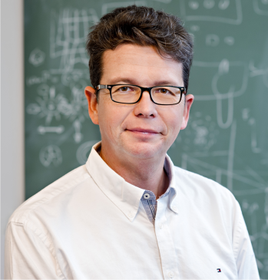报告题目:Nanostructured polymer films for energy harvesting applications
报告人:Peter Müller-Buschbaum教授(德国慕尼黑工业大学)
报告时间:2019年10月10日(星期四)上午10:00-11:00
报告地点:长安校区启翔楼357会议室
邀请人:宋霖教授、陈永华教授
承办学院:柔性电子研究院
联系人:张倩文
联系电话:88460889
报告简介:
Among the next generation solar cells, in particular organic photovoltaics are gaining impact as a promising alternative to conventional silicon-based solar cells. Using nanostructured polymer films as active material for the energy conversion offers several potential advantages, as for instance the material availability and low-cost processing techniques. Due to the potential device flexibility and tunable colors and shapes, organic photovoltaics could be integrated into a wide range of applications, combining functionality with design in fields as diverse as mobility, architecture or clothing. However, efficiencies of organic solar cells still stay far below those of their commercially available inorganic counterparts, which demonstrates the need for strengthened fundamental understanding.
In particular the morphology of the active layer of the organic solar cells is of highest importance for the device performance, because it needs to facilitate exciton creation, exiton migration and splitting at tailored interfaces and transport of the generated charge carriers to the corresponding electrodes. All these different tasks require an optimized polymer nanostructure, which in turn requires techniques being capable of probing these nanostructures of the active layers of solar cells. Using advanced scattering techniques such as grazing incidence small angle X-ray and neutron scattering (GISAXS and GISANS) enables to probe the morphology of the active layers from the molecular to the mesoscopic scale. As a result a structure function-relationship can be established, which provides insights into fundamentals of organic solar cells. In-situ investigations enable deeper understanding of film formation and device degradation.
报告人介绍:

Peter Müller-Buschbaum is full professor in the Physics Department at the Technical University of Munich, Germany, heading the Chair of Functional Materials. Moreover, he is scientific director of the Munich neutron source FRM-II and scientific director of the Heinz Maier-Leibnitz Zentrum MLZ. He is heading the keylab “TUM.solar”, which focuses on research of solar energy conversion and storage based on nanomaterials. He is heading the “Network for Renewable Energies” (NRG) of the “Munich School of Engineering” (MSE), and he is the German representative at the “European Polymer Federation” (EPF) for polymer physics. He is elected chairman of the “Hamburg User Committee” (HUC) at the synchrotron radiation laboratory DESY in Hamburg, member of the “European Synchrotron User Organization” (EUSO) and associate editor of the journal “ACS Applied Materials & Interfaces”. His research interests cover polymer and hybrid materials for energy applications with a special focus on thin films and nanostructures, including kinetic, in-situ and in-operando experiments on solar cells, thermoelectric materials and batteries.